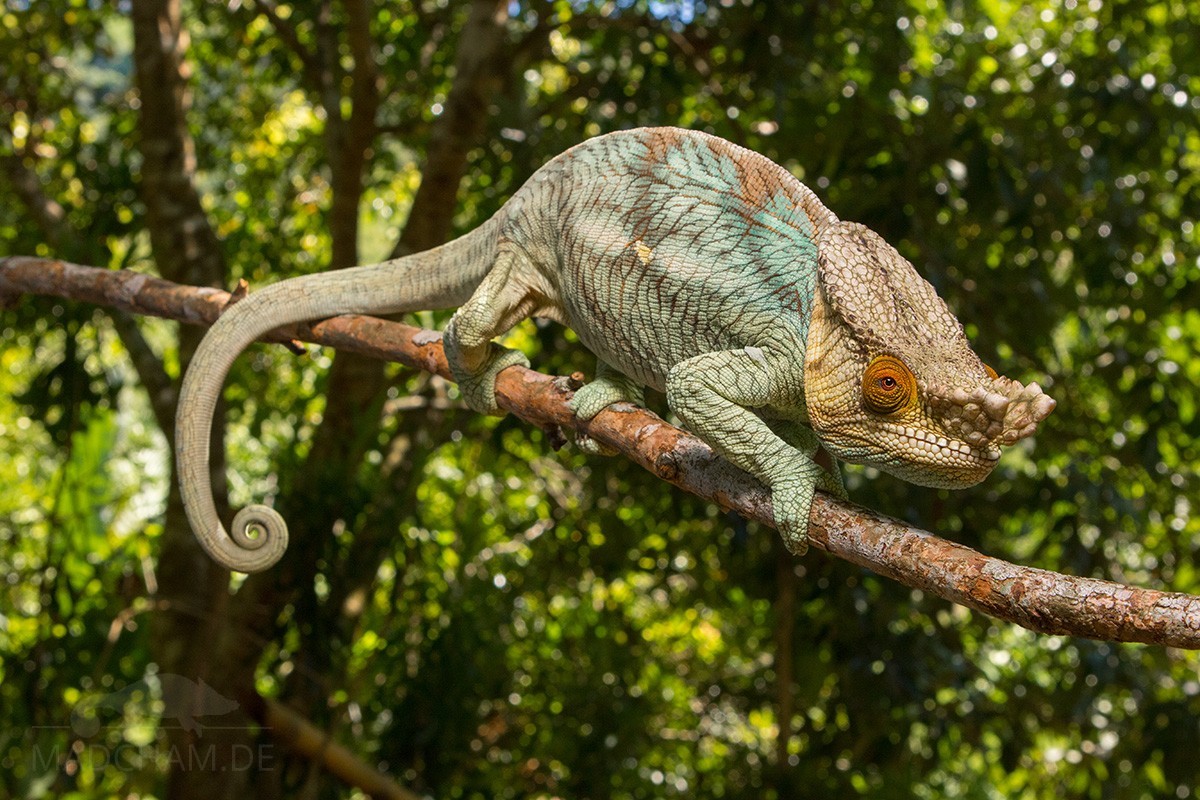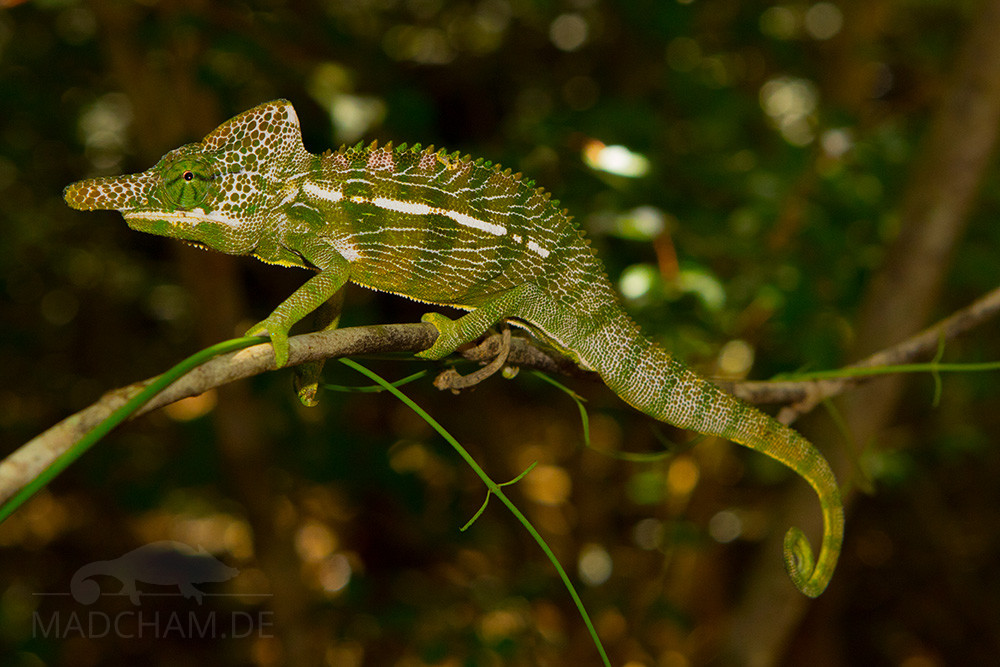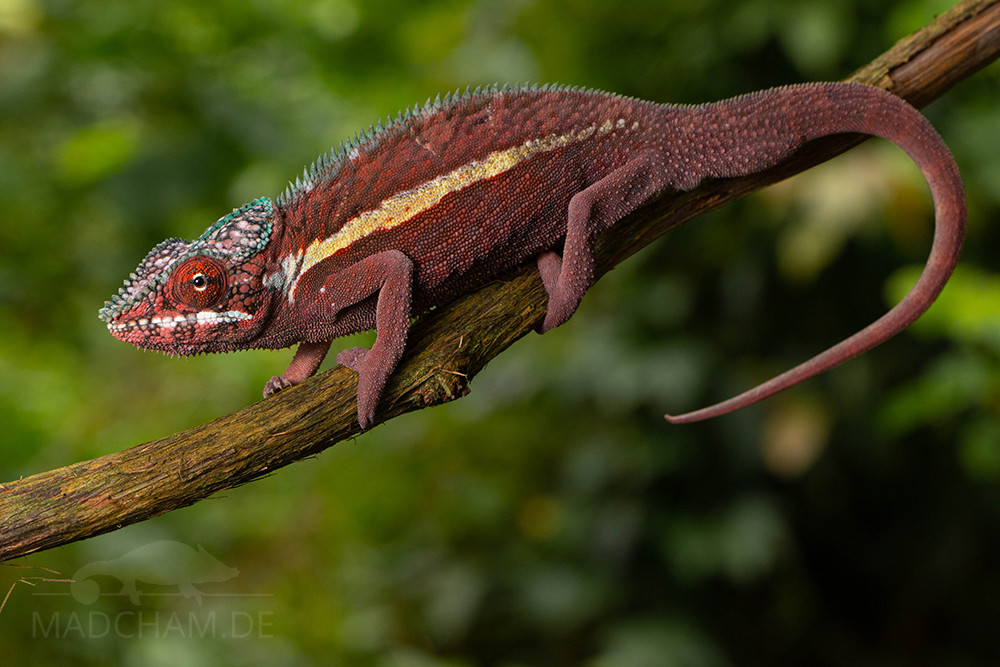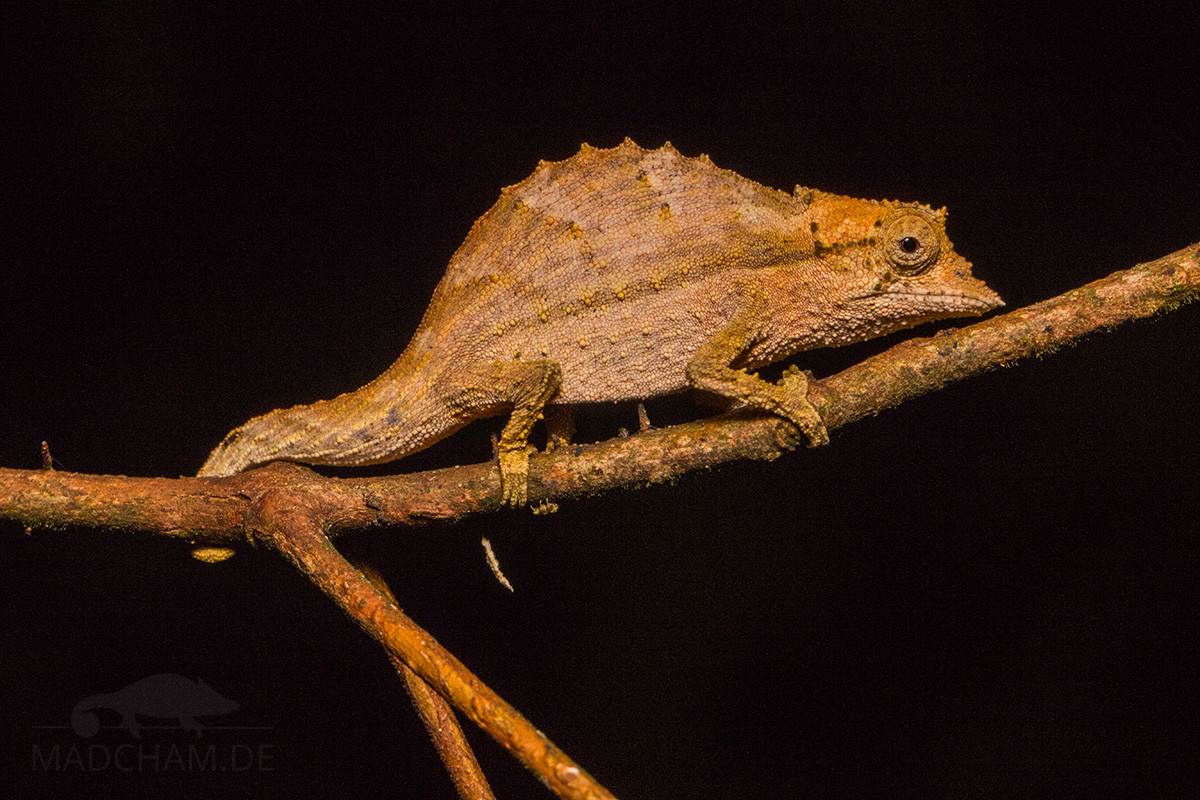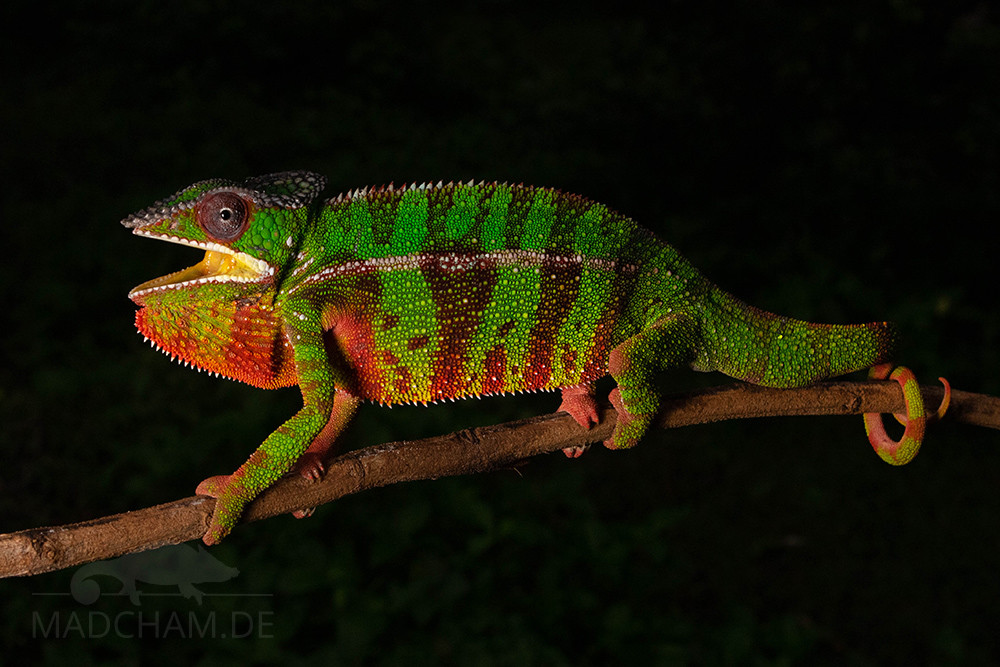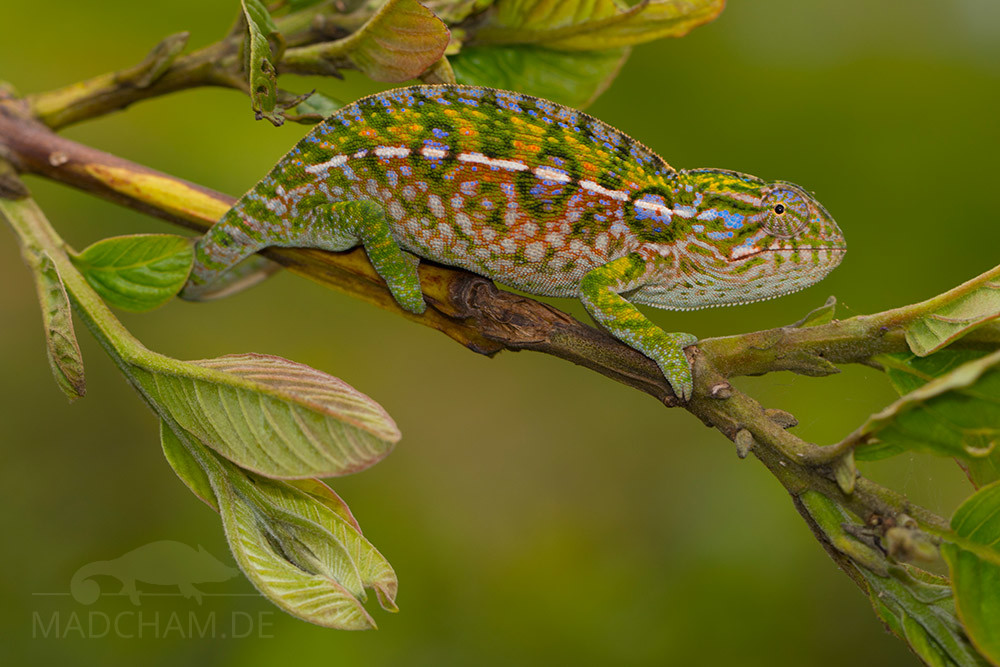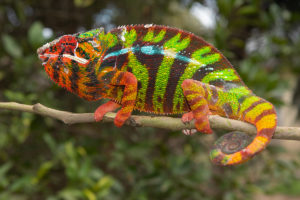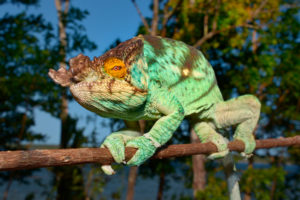Inhaltsverzeichnis
What is UVB radiation?
UVB is the abbreviation for Ultraviolet B. This is a part of the solar radiation that reaches the earth. Only about 5% of the sun’s rays are ultraviolet rays at all. They are divided into UVA, UVB, and UVC depending on the wavelength of the radiation. UVA covers wavelengths from 380 to 315 nm. UVB is the ultraviolet that is important for chameleons and is discussed in more detail in this article. It contains wavelengths from 315 to 280 nm, which is a very narrow radiation range. UVC rays with wavelengths from 280 to 100 nm are mostly absorbed by the uppermost air layers of the earth’s atmosphere, so they do not reach the earth at all. Ultraviolet radiation is not visible to the human eye.

The spectrum of electromagnetic radiation on earth
Why does a chameleon need UVB radiation?
UVB radiation is vital for chameleons. Vitamin D3 (cholecalciferol) is produced in the skin by UVB radiation from provitamin D (7-dehydrocholesterol). “Too much” vitamin D3 decomposes again when it is not needed in the blood. The vitamin D3 released into the blood is transported to the liver where it is converted to calcidiol. Vitamin D3 is then transported to the kidneys where it is metabolized into calcitriol. The hormone calcitriol ensures the incorporation of calcium into the chameleon’s bones. If there is too little calcium in the blood, the formation of vitamin D3 in the skin of the chameleon is increased. However, this only happens when there is sufficient UVB radiation.
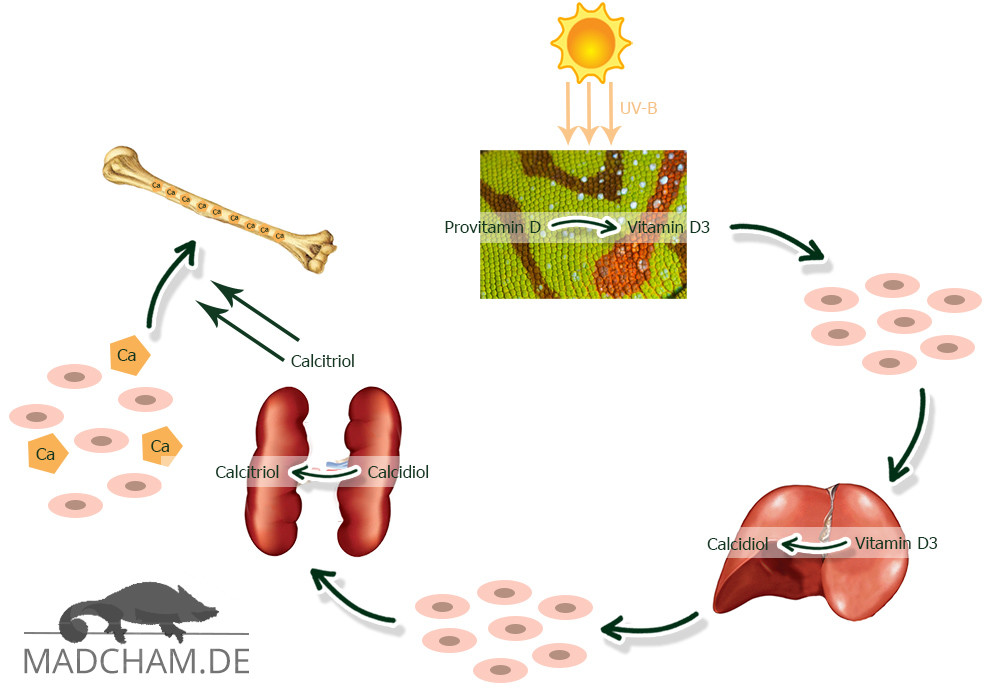
A lack of UVB radiation leads to the chameleon over a decreased calcium blood level to the increased release of parathormone. This hormone stimulates the bones to break down calcium and release it into the blood. The kidney stops filtering calcium back out of the blood. At the same time, less calcium is absorbed from the intestines. Ultimately, calcium deficiency leads to life-threatening metabolic bone disease.
In addition to this vital process, UVB also contributes to well-being, better reproduction, and a more active metabolism in chameleons. It is also assumed that chameleons can see in the UVA range (not in the UVB range!) so ultraviolet radiation also influences their communication and perception. Studies have shown that chameleons adapt their behaviour to their vitamin D3 needs. They spend more time under UV-B radiation when more vitamin D3 is needed. How exactly they recognize when they need to sunbathe more and when has not yet been studied in detail.
Measurement of UVB radiation
Why should you measure UVB?
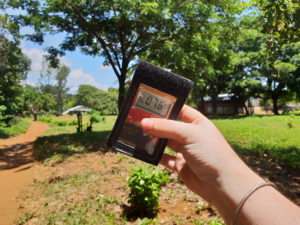
UVB measurements with the Solarmeter 6.5 on the island of Nosy Faly in northwest Madagascar
Online and in specialized stores, there are today a lot of different UV-B lamps to buy. With many already the packing suggests how much UVB the respective lamp is to deliver. Unfortunately, this information is not very reliable. If you measure lamps regularly, it is noticeable that even within a single batch differences in UVB radiation can occur. Some lamps emit UV-B that is too short-waved or emit radiation in the range of much too high UVB indices. These lamps can cause severe burns. Other lamps emit little or no UVB, which later leads to calcium deficiency and metabolic bone disease in chameleons. So it is very important to measure lamps for terrariums and to align them appropriately for the chameleon.
The re-measurement not only ensures that the chameleon gets the “right amount” of UVB but it also allows us as the owner to find the right time for lamp replacement. So you do not throw away a lamp too early anymore, although it might still be usable. On the other hand, lamps can be sorted out exactly when they no longer provide enough UVB. And if a lamp really does not emit any UVB at all, you can directly return it to the manufacturer.
Which measuring device can be used?
In the meantime, there are several devices that can be used to measure UVB radiation. However, not all of them are suitable for reptiles. For the measurement of UVB sources above the terrarium, it is important to know how much vitamin D3 the chameleon can effectively produce with it. The optimal measuring device should therefore measure as exactly as possible the wavelengths in which the animal produces vitamin D3. Fortunately, such a “vitamin D3 synthesis curve” already exists. And even better: there is a measuring device whose measuring range coincides with this curve by more than 90%.
The Solarmeter 6.5 with a silicon carbide photodetector is manufactured by Solar Light Company Inc. (USA) and currently costs 250 $. The identical measuring device is distributed by Zoo Med under the name Digital UV Index Radiometer. The Solarmeter 6.5 measures the so-called UV Index, an internationally used scientific quantity. The Solarmeter can be used for years without having to be calibrated. Recently the model 6.5 R has been released, but it differs from the Solarmeter 6.5 only by a different sticker. It is powered by a 9V battery, which can be easily replaced. We regularly use Solarmeters 6.5 on Madagascar, they have been proving themselves for years.
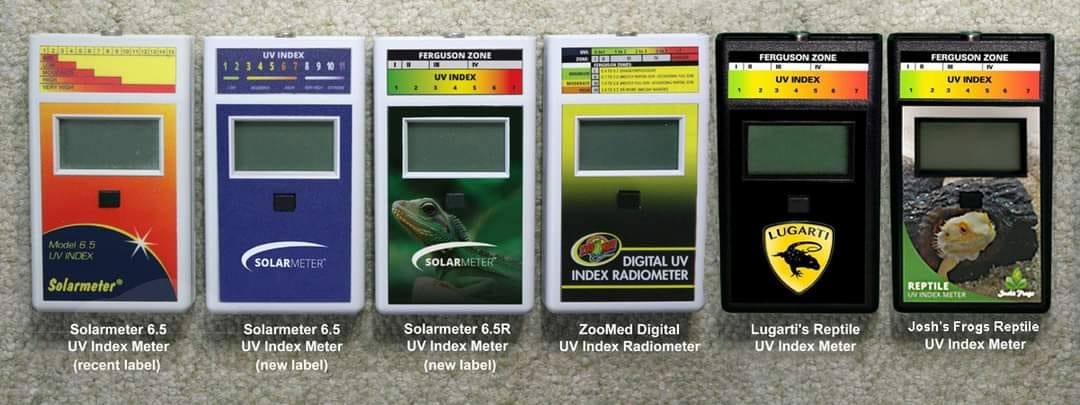
The different stickers of the Solarmeter 6.5 in comparison: On the left is the old design, right of it are the two current stickers, and on the far right are the three variants of ZooMed, Lugarti and Josh’s Frogs. The devices are all identical in construction. Photo courtesy of Frances Baines, uvguide.co.uk
At present, there are no other measuring devices that come close to the accuracy of the Solarmeter 6.5 for measuring UVB in terraristics. Cell phone Apps, cheap China copies, and also allegedly high-quality, but cheaper measuring instruments are unfortunately not meaningful. By not following exactly the synthesis curve of vitamin D3, these measuring devices show falsified measured values. It is of no use to measure any UVB range. The range, in which the Chameleon can form Vitamin D3, is the one that must be measured. The “other” UVB is of no use to the animal! The false readings from cheap measuring devices are useless for the chameleon at best, but can also be extremely dangerous. Here you should therefore not save at the wrong end under any circumstances.
How and where to measure?
It is important that Solarmeter 6.5 is used to measure inside the terrarium – exactly where the chameleon is. Due to the gauze in the terrarium lid used for chameleons, about 30% of the UVB radiation is absorbed. Fruit fly-proof gauze with very small mesh sizes can even absorb up to 50% of UVB radiation. It is therefore worthwhile to consider which mesh size you want to use already when building the terrarium. Because of the high risk of burns, lamps cannot be installed inside the terrarium for chameleons. A grid between terrariums and lamps is always necessary for chameleons.
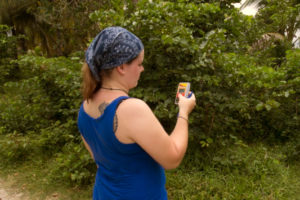
UVB measurements with the Solarmeter 6.5 in Maroantsetra in northeast Madagascar
Measuring the UV index with the Solarmeter 6.5 is very easy. Measurements should be taken in or near the central beam of the lamp, as the highest UV index is expected there. Hold the solar meter with the sensor towards the lamp and press the black button. The UV index is now shown directly in the display. Then you move the solar meter horizontally with your hand very slowly under the lamp to find the highest point of the measurement. It is best to measure not only directly under the gauze of the terrarium but also at the sunny spots the chameleon can reach. The lamp above the terrarium should be hung up in a way that the maximum UV index the chameleon should be able to reach is directly under the lid gauze. Chameleons like to climb around upside down on gauze. Therefore not only the sunny spots should be considered, but also under the gauze cover, the animal should be able to move without risk of injury.
Very important: If you measure the UVB radiation of a lamp directly in the terrarium, all other UV-B lamps in the vicinity should be switched off at the same time. Otherwise, you might measure their radiation and not the radiation of the lamp you wanted to measure.
To measure lamps for the first time, the burn-in time should be considered. It takes at least 30 minutes on average until the “real” UVB index of a lamp can be measured. At best you let a lamp run for even a whole day before you measure it with the solarmeter 6.5. After the first measurement and alignment to match the needs of your chameleon, we recommend at least monthly remeasurement of each lamp.
UV-Indices on Madagascar
You can find UV indices that we measured directly in the chameleon habitats on Madagascar in the section “Species & habitat data”. Please note that these data represent the maximum UV indices that can be reached by a chameleon at the respective location. However, most chameleon species do not spend the whole day in the blazing sun, but most of the time in shady areas. Even “sun worshippers” like panther chameleons only sunbathe for a limited time of the day. Some species are more common in sunny places than others, only a few chameleons sunbathe in the midday heat. Leaf chameleons generally get hardly any UVB on the ground, although individual sunspots reach amazingly high UV indices even in the deepest rainforest.
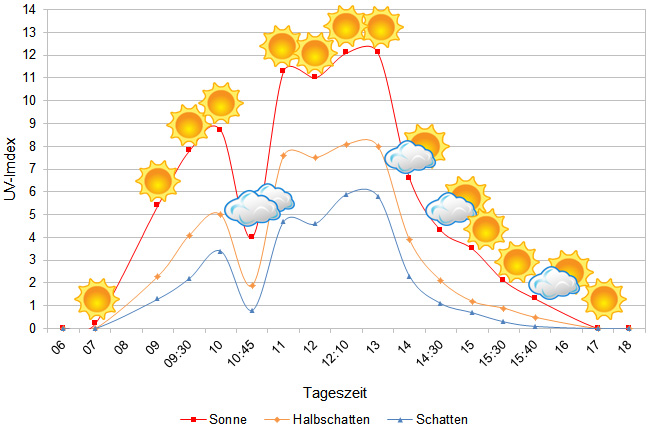
UV indices under different weather conditions, measured over a whole day in March 2016 near Ambilobe in northwest Madagascar; translation: Tageszeit = daytime, Sonne = sun, Halbschatten = half shade, Schatten = shade.
In addition, the UV index on Madagascar depends extremely on the weather conditions and the time of day. The UV index increases and decreases with the time of day. Shortly after noon with the highest level of the sun, the highest values are reached. In the early morning and late afternoon, almost no UVB can be measured in Madagascar. When it rains heavily or there are many clouds in the sky, the UV index is much lower than when the sun is blazing at the same time of day. So in nature, there is no constant UV index, but an extremely variable UV index with many outliers up and down.
In order to imitate UV indices exactly like in nature in a terrarium, a terrarium has to be dimensioned generously and above all, it has to have excellent planting. The chameleon must be able to choose which UVB range it wants to use. Caution is also indicated here with the temperatures: In nature, the UVB value is highest where it is warmest. This is not always the case with terrarium lamps. There you may have to readjust very precisely with brightness, temperature, and UVB.
If you want to make it easier for yourself and “play it safe” in chameleon keeping, the Ferguson zones are the right choice.
Ferguson zones
In 2009, biologist Gary Ferguson and five colleagues published an article dealing with reptiles in North America and Jamaica. They measured 15 different snakes and lizards to see what UV indices these voluntarily exposed themselves to in nature, when, and how. Then they sorted the 15 species into four different zones, the so-called Ferguson zones, according to their behaviour. For the first time, they published guidelines on which UV indices could be used for which reptile species in terraristics. Ferguson et al. also recommended measuring with the Solarmeter 6.5 in natural habitats in order to determine the average and maximum exposure levels of different reptiles.
| Median UV Index | Maximum UV Index | ||
| Zone 1 | 0-0,7 | 0,6-1,4 | Crepuscular or shade dweller |
| Zone 2 | 0,7-1,0 | 1,1-3,0 | Partial sun or occasional basker |
| Zone 3 | 1,0-2,6 | 2,9-7,4 | Open or partial sun basker |
| Zone 4 | 2,6-3,5 | 4,5-9,5 | ‘Mid-day’ open sun baskers |
The Ferguson zones offer a rough orientation for the terrarium. They are, in simple terms, “safe” areas to avoid burns from UVB radiation, but at the same time to provide a reptile in the terrarium with the necessary amount of UVB radiation. The values of the zones do not necessarily correspond to what a chameleon finds in Madagascar. This is not even possible with the original article, because on the one hand non-Madagascan chameleons were examined and on the other hand, nothing was measured on Madagascar to create the Ferguson zones.
In 2016, veterinarian Frances Baines and seven other colleagues published concrete recommendations for the classification of many common reptile species into the existing Ferguson zones. They also developed recommendations for the use of different lamps. At least three chameleon species made it into this publication, even though there are still no published locality measurements from Madagascar for them. In 2021, Ferguson et al. revised the estimate for Furcifer pardalis one zone upward.
| Median UV Index | Maximum UV index | ||
| Zone 1 | 0-0,7 | 0,6-1,4 | Brookesia superciliaris |
| Zone 2 | 0,7-1,0 | 1,1-3,0 | |
| Zone 3 | 1,0-2,6 | 2,9-7,4 | Calumma parsonii |
| Zone 4 | 2,6-3,5 | 4,5-9,5 | Furcifer pardalis |
Modified Ferguson zones for Malagasy chameleons
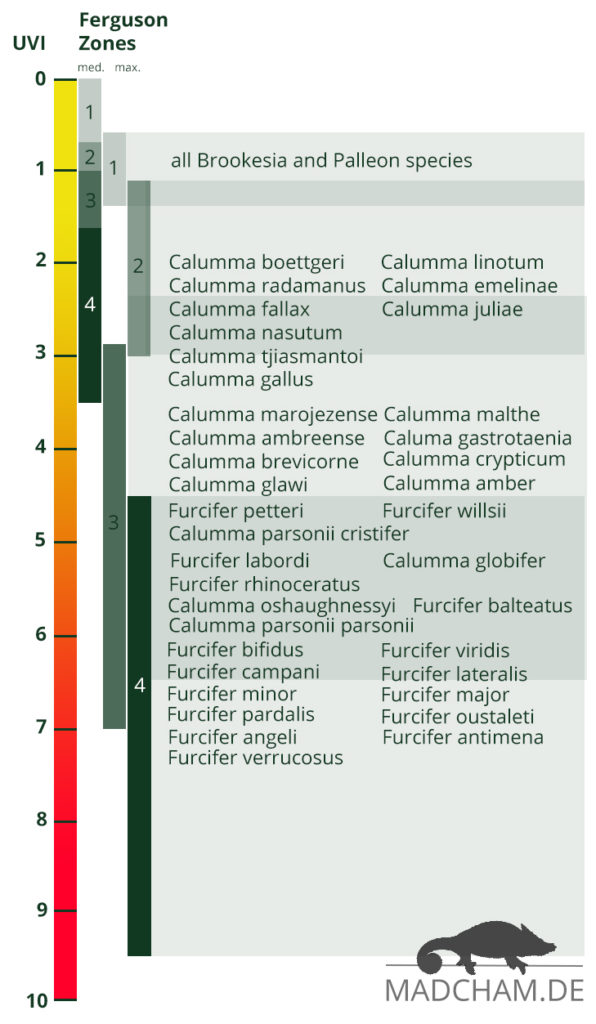
Modified Ferguson zones for Malagasy chameleons
Unfortunately, there is no research yet on which chameleon species in Madagascar prefers which UV index. We are currently working on on-site measurements of the different species in Madagascar. Based on our observations over the years, we propose the division of the different species shown here on the right into modified Ferguson zones. We do not use a rigid table, but a bar with an increasing UV index, because some species can be observed in the sun much more often than others and therefore probably can cope with higher UV indexes. For example, although we think that both Calumma brevicorne and Furcifer balteatus are in zone 3, Calumma brevicorne sunbathes less frequently and less intensively than Furcifer balteatus.
This classification is only a suggestion. We have divided the species into different zones mainly based on the behaviour we observed. But since we cannot observe a chameleon 24 hours a day for 365 days a year, these are rough estimates, nothing more. There are also some species missing, where we lack current observations and therefore have not yet included them in the table.
Are there alternatives for measuring UVB?
Yes, there is. When there were no solar meters yet, the UVB supply had to be ensured differently. In order to do so, people used a very special mixed light lamp, the Osram Ultra Vitalux 300 W. A ballast is not necessary with this lamp. It has been on the market since 1928 with small improvements, has more than proven itself in this time, and originally comes from human needs. The Vitalux was used in the prophylaxis and therapy of rachitic children. For chameleons, the lamp only needs to be used for 30 minutes daily, whereby a safety distance of 80 to 100 cm from the chameleon should always be maintained. A porcelain socket is suitable for use as with many other lamps because the lamp gets very hot during use. Since most chameleon keepers do not have one and a half meter space above the terrarium, the chameleon usually has to be taken out of the terrarium to use the lamp. If you do not want to buy a solarmeter, you should not go without a Vitalux. By the way, the Radium Sanolux is identical in construction to the Osram Ultra-Vitalux. The Osram Ultra Vitalux is still frequently used in the therapy of sick chameleons.
In summer, UVB radiation can be obtained by keeping chameleons in an outside enclosure, depending on where you live and depending on your outside temperatures. This does not replace UVB radiation in winter.
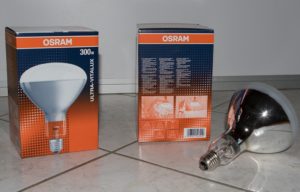
Current packaging of the Osram Ultra Vitalux
By the way, it is no alternative to let a chameleon “sit by the window to sunbathe“. Unfortunately, UVB radiation does not penetrate through glass, so the chameleon does not get any UVB radiation there.
Iso irradiation charts
Those who measure out new lamps more frequently can share the values with other reptile keepers and thus contribute to broader knowledge about the UVB radiation of the different lamps. To measure lamps for more than just your own use in the terrarium, so-called Iso Irradiance Charts are used. Such a diagram shows the UVB radiation of a certain lamp or its course in two dimensions. Instructions on how to create such a diagram at home can be found here and here.
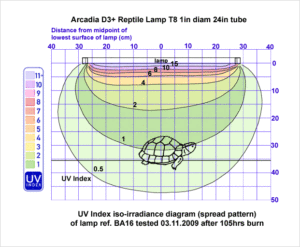
Example of an Iso Irradiance Chart. Photo courtesy of Frances Baines, uvguide.co.uk
The diagrams of individual lamps of the same type look very similar in principle. A metal halide lamp, for example, usually emits intense UVB radiation over a relatively narrow range, while a fluorescent tube emits very uniform UV-B radiation over a large area. Here is a good overview of which diagram can be expected for which lamp type. Below the diagram, the manufacturer of the measured lamp, the lamp type, the name as well as burning time in hours, and batch number are indicated. This information is important because the UVB radiation decreases with time and can vary even within the same batch.
The diagrams can help you to find the right type of lamp for your own chameleon terrarium. They can also be helpful when positioning a lamp above the terrarium. However, the diagrams do not replace the regular measurement of a purchased lamp!
Iso-irradiance diagrams of a whole range of lamps can be found under the following links:
Arcadia D3+ Reptile Lamp T8
Arcadia D3+ 12% UVB Reptile Lamp T8 18 W
Arcadia D3 6% UVB Reptile Lamp T5
Arcadia D3+ 12% UVB Reptile Lamp T5
Arcadia Pro T5 UVB Kit 24 W + Dragon 14% UVB
Arcadia Pro T5 UVB Kit 24 W + Desert 12 % UVB
Arcadia Pro T5 UVB Kit 24 W + Forest 6% UVB
Hobby UV Power Star 70 W
Lucky Reptile Bright Sun UV Desert 50 W
Lucky Reptile Bright Sun UV Desert 50 W
Repti-Zoo HO T5 UVB Lighting Combo Kit 24 W + Desert UVB 10.0
Reptiles Expert UVB MD-Lampe 50 W
Reptiles Expert UVB MD-Lampe 70 W
Zoo Med ReptiSun 5.0 UVB T8
ZooMed PowerSun 160 W
ZooMed ReptiSun 5.0 T8 18 W
Zoo Med ReptiSun 10.0 UVB T8 18W

